Tele-Health System Analysis and Design for Headspace Application
VerifiedAdded on 2023/06/08
|10
|1766
|73
Report
AI Summary
This report presents a system analysis and design for the Headspace Tele-Health system, focusing on automating the system for patients aged 12-25. It includes a stakeholder map identifying internal and external executives and operational stakeholders, such as patients, staff, government, and cloud vendors. A questionnaire is proposed to gather feedback from stakeholders about the system's effectiveness and usability. The report also features a use case diagram detailing the interactions between actors like doctors, patients, and administrators, outlining the process of signing up, updating information, and managing patient data. The goal is to create an efficient and secure system that improves the treatment process and facilitates communication among stakeholders within the Headspace organization. Desklib offers a variety of similar documents and study tools for students.
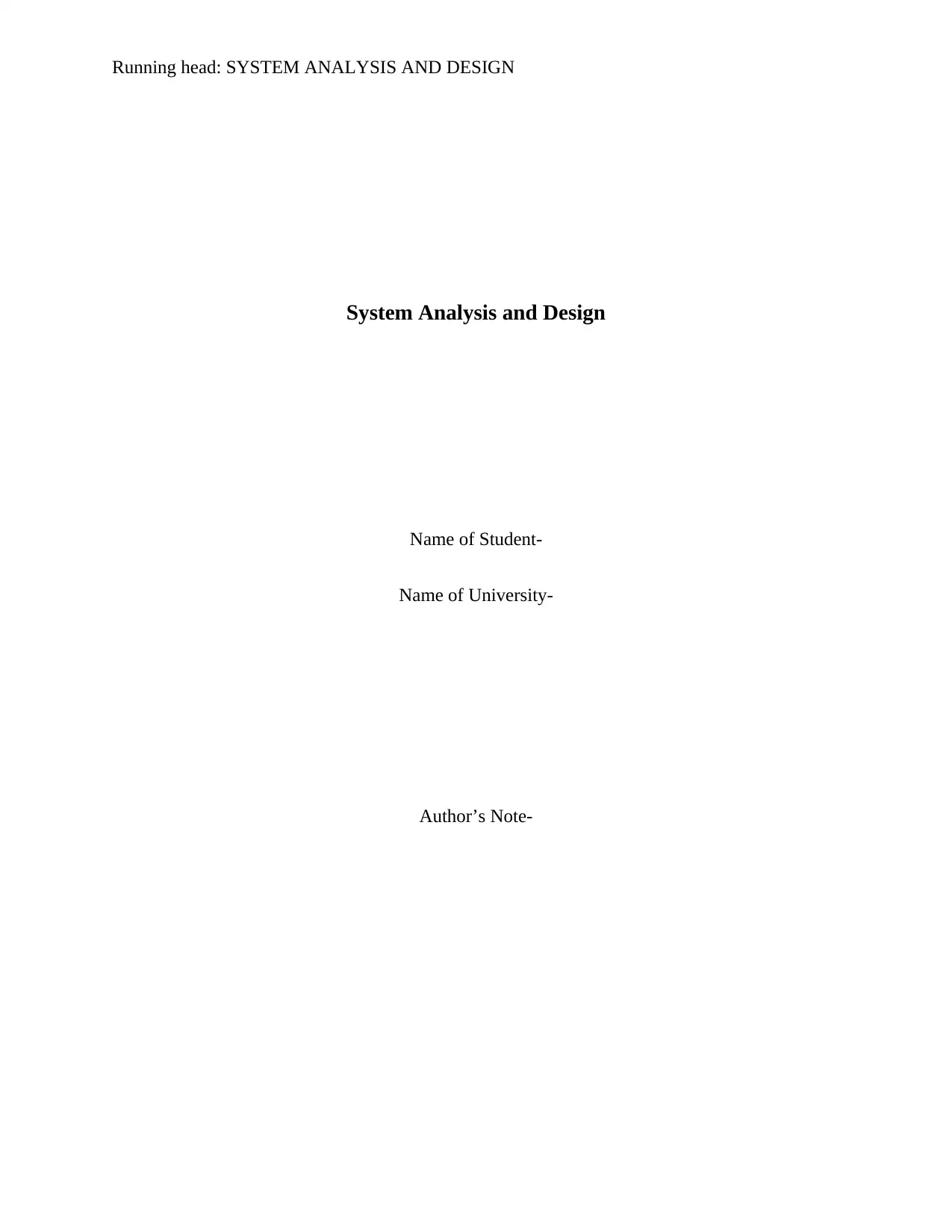
Running head: SYSTEM ANALYSIS AND DESIGN
System Analysis and Design
Name of Student-
Name of University-
Author’s Note-
System Analysis and Design
Name of Student-
Name of University-
Author’s Note-
Paraphrase This Document
Need a fresh take? Get an instant paraphrase of this document with our AI Paraphraser
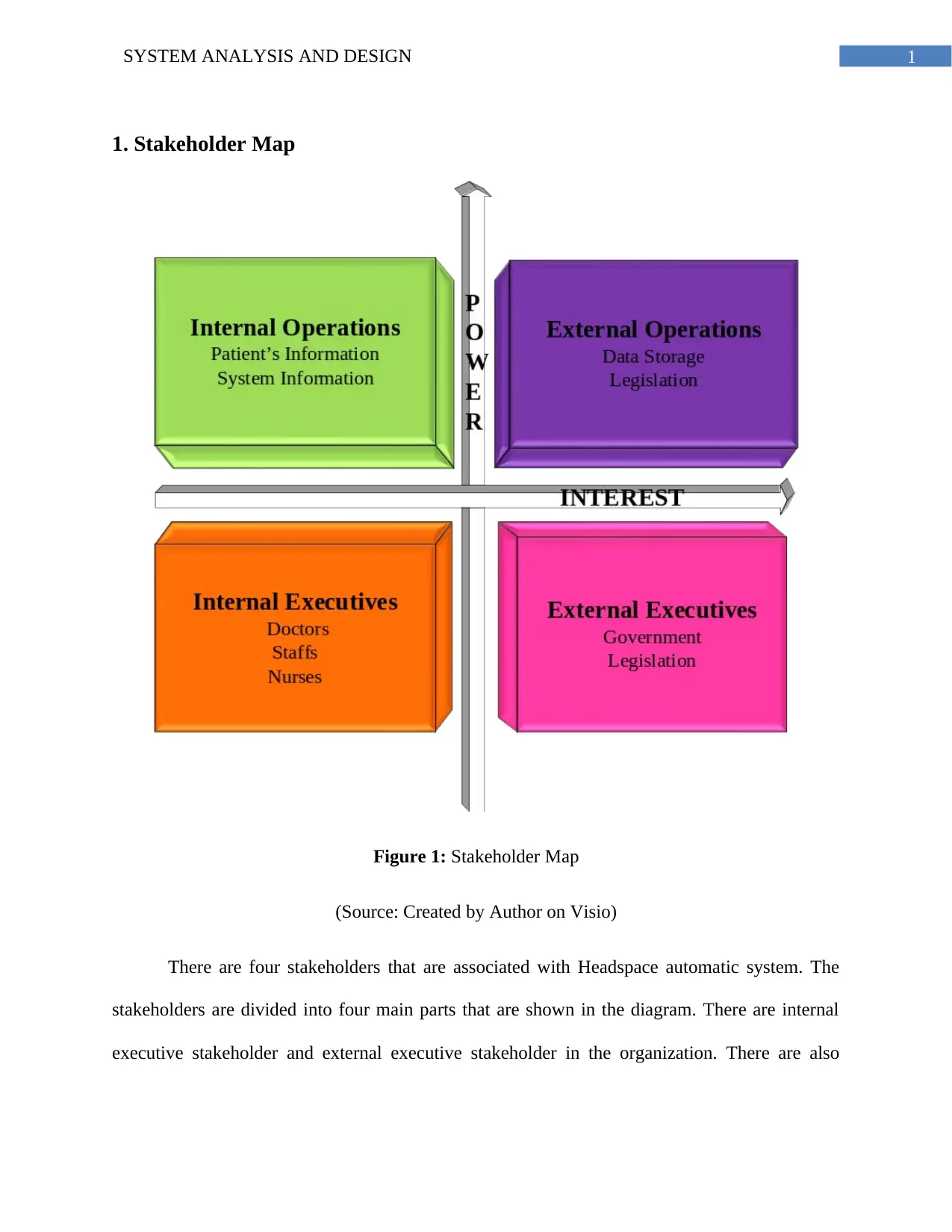
1SYSTEM ANALYSIS AND DESIGN
1. Stakeholder Map
Figure 1: Stakeholder Map
(Source: Created by Author on Visio)
There are four stakeholders that are associated with Headspace automatic system. The
stakeholders are divided into four main parts that are shown in the diagram. There are internal
executive stakeholder and external executive stakeholder in the organization. There are also
1. Stakeholder Map
Figure 1: Stakeholder Map
(Source: Created by Author on Visio)
There are four stakeholders that are associated with Headspace automatic system. The
stakeholders are divided into four main parts that are shown in the diagram. There are internal
executive stakeholder and external executive stakeholder in the organization. There are also
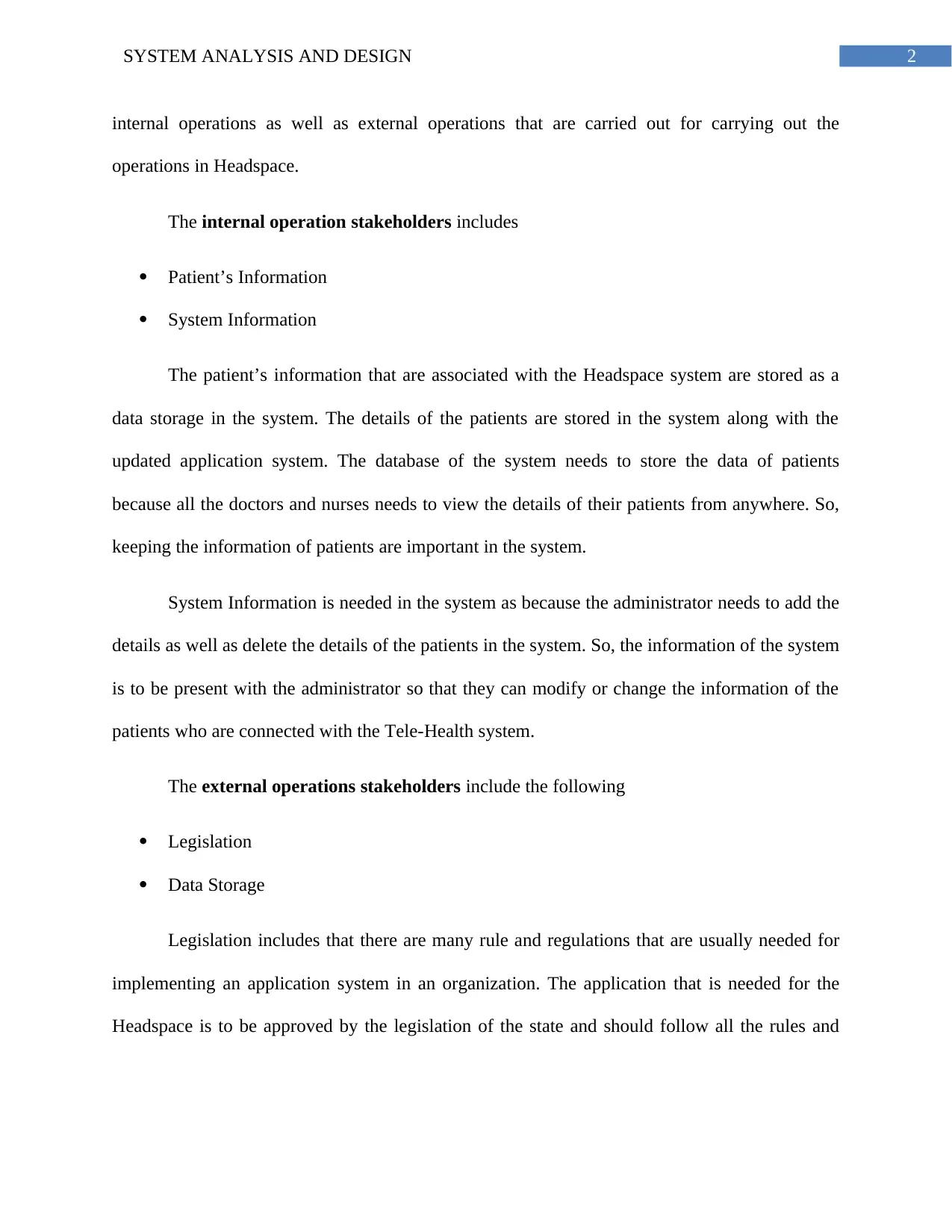
2SYSTEM ANALYSIS AND DESIGN
internal operations as well as external operations that are carried out for carrying out the
operations in Headspace.
The internal operation stakeholders includes
Patient’s Information
System Information
The patient’s information that are associated with the Headspace system are stored as a
data storage in the system. The details of the patients are stored in the system along with the
updated application system. The database of the system needs to store the data of patients
because all the doctors and nurses needs to view the details of their patients from anywhere. So,
keeping the information of patients are important in the system.
System Information is needed in the system as because the administrator needs to add the
details as well as delete the details of the patients in the system. So, the information of the system
is to be present with the administrator so that they can modify or change the information of the
patients who are connected with the Tele-Health system.
The external operations stakeholders include the following
Legislation
Data Storage
Legislation includes that there are many rule and regulations that are usually needed for
implementing an application system in an organization. The application that is needed for the
Headspace is to be approved by the legislation of the state and should follow all the rules and
internal operations as well as external operations that are carried out for carrying out the
operations in Headspace.
The internal operation stakeholders includes
Patient’s Information
System Information
The patient’s information that are associated with the Headspace system are stored as a
data storage in the system. The details of the patients are stored in the system along with the
updated application system. The database of the system needs to store the data of patients
because all the doctors and nurses needs to view the details of their patients from anywhere. So,
keeping the information of patients are important in the system.
System Information is needed in the system as because the administrator needs to add the
details as well as delete the details of the patients in the system. So, the information of the system
is to be present with the administrator so that they can modify or change the information of the
patients who are connected with the Tele-Health system.
The external operations stakeholders include the following
Legislation
Data Storage
Legislation includes that there are many rule and regulations that are usually needed for
implementing an application system in an organization. The application that is needed for the
Headspace is to be approved by the legislation of the state and should follow all the rules and
⊘ This is a preview!⊘
Do you want full access?
Subscribe today to unlock all pages.

Trusted by 1+ million students worldwide
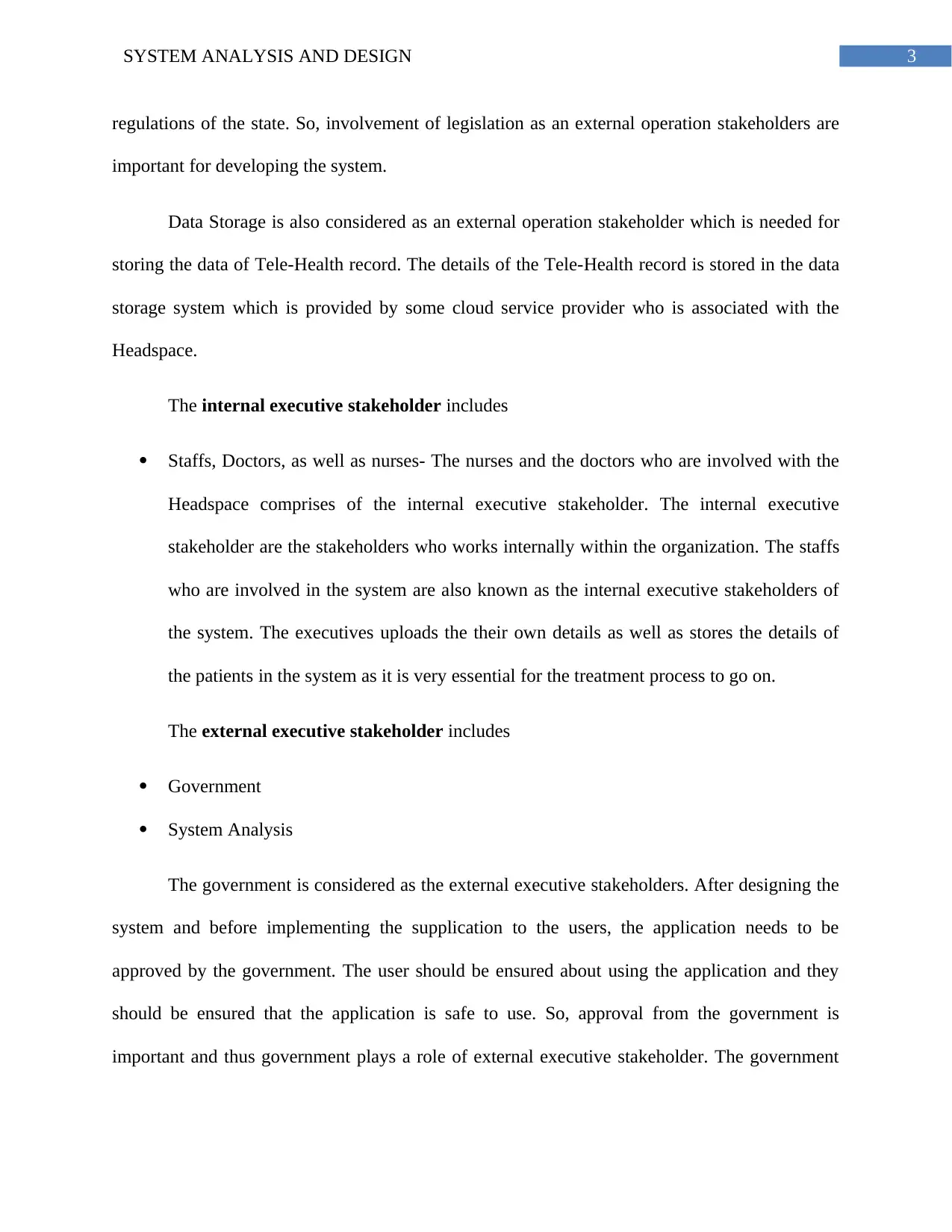
3SYSTEM ANALYSIS AND DESIGN
regulations of the state. So, involvement of legislation as an external operation stakeholders are
important for developing the system.
Data Storage is also considered as an external operation stakeholder which is needed for
storing the data of Tele-Health record. The details of the Tele-Health record is stored in the data
storage system which is provided by some cloud service provider who is associated with the
Headspace.
The internal executive stakeholder includes
Staffs, Doctors, as well as nurses- The nurses and the doctors who are involved with the
Headspace comprises of the internal executive stakeholder. The internal executive
stakeholder are the stakeholders who works internally within the organization. The staffs
who are involved in the system are also known as the internal executive stakeholders of
the system. The executives uploads the their own details as well as stores the details of
the patients in the system as it is very essential for the treatment process to go on.
The external executive stakeholder includes
Government
System Analysis
The government is considered as the external executive stakeholders. After designing the
system and before implementing the supplication to the users, the application needs to be
approved by the government. The user should be ensured about using the application and they
should be ensured that the application is safe to use. So, approval from the government is
important and thus government plays a role of external executive stakeholder. The government
regulations of the state. So, involvement of legislation as an external operation stakeholders are
important for developing the system.
Data Storage is also considered as an external operation stakeholder which is needed for
storing the data of Tele-Health record. The details of the Tele-Health record is stored in the data
storage system which is provided by some cloud service provider who is associated with the
Headspace.
The internal executive stakeholder includes
Staffs, Doctors, as well as nurses- The nurses and the doctors who are involved with the
Headspace comprises of the internal executive stakeholder. The internal executive
stakeholder are the stakeholders who works internally within the organization. The staffs
who are involved in the system are also known as the internal executive stakeholders of
the system. The executives uploads the their own details as well as stores the details of
the patients in the system as it is very essential for the treatment process to go on.
The external executive stakeholder includes
Government
System Analysis
The government is considered as the external executive stakeholders. After designing the
system and before implementing the supplication to the users, the application needs to be
approved by the government. The user should be ensured about using the application and they
should be ensured that the application is safe to use. So, approval from the government is
important and thus government plays a role of external executive stakeholder. The government
Paraphrase This Document
Need a fresh take? Get an instant paraphrase of this document with our AI Paraphraser
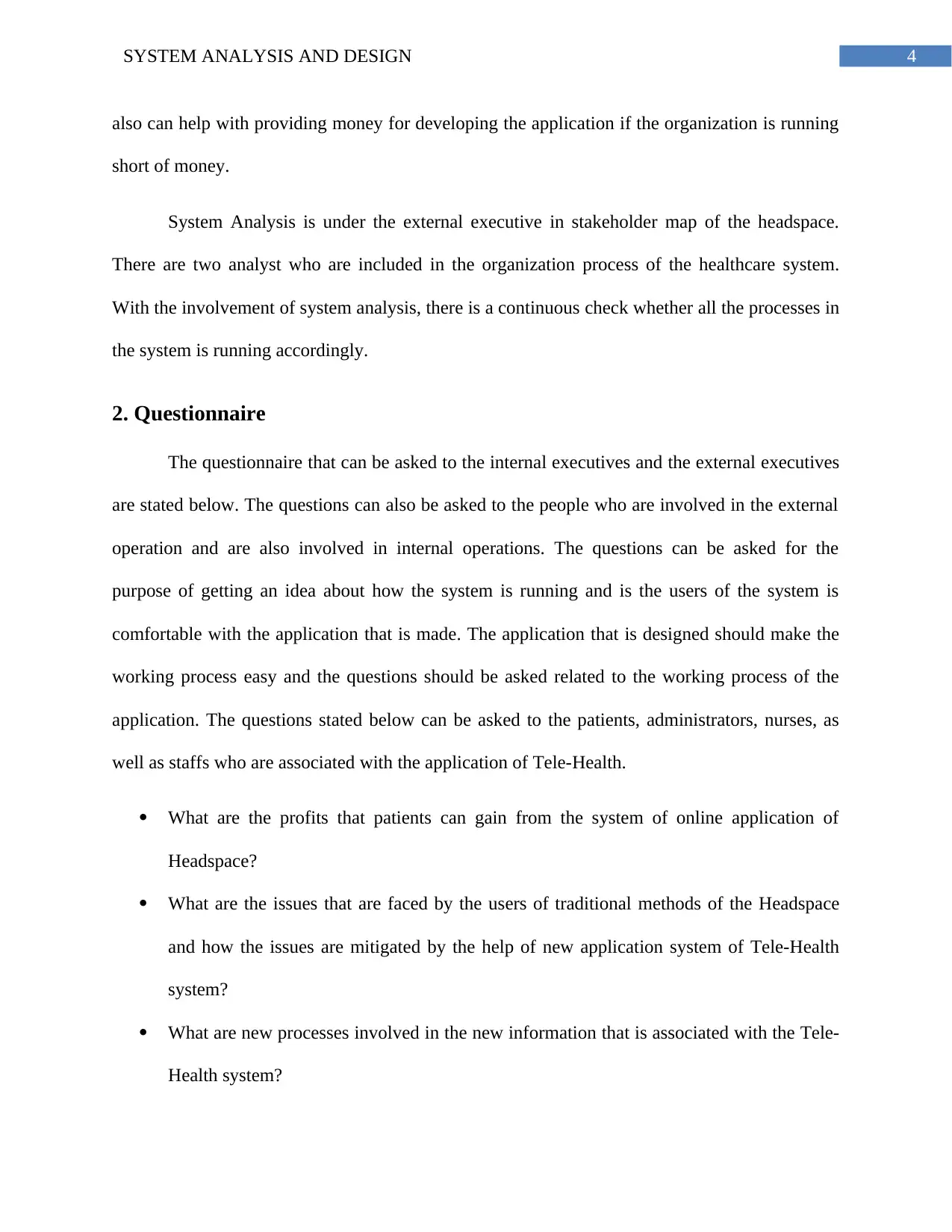
4SYSTEM ANALYSIS AND DESIGN
also can help with providing money for developing the application if the organization is running
short of money.
System Analysis is under the external executive in stakeholder map of the headspace.
There are two analyst who are included in the organization process of the healthcare system.
With the involvement of system analysis, there is a continuous check whether all the processes in
the system is running accordingly.
2. Questionnaire
The questionnaire that can be asked to the internal executives and the external executives
are stated below. The questions can also be asked to the people who are involved in the external
operation and are also involved in internal operations. The questions can be asked for the
purpose of getting an idea about how the system is running and is the users of the system is
comfortable with the application that is made. The application that is designed should make the
working process easy and the questions should be asked related to the working process of the
application. The questions stated below can be asked to the patients, administrators, nurses, as
well as staffs who are associated with the application of Tele-Health.
What are the profits that patients can gain from the system of online application of
Headspace?
What are the issues that are faced by the users of traditional methods of the Headspace
and how the issues are mitigated by the help of new application system of Tele-Health
system?
What are new processes involved in the new information that is associated with the Tele-
Health system?
also can help with providing money for developing the application if the organization is running
short of money.
System Analysis is under the external executive in stakeholder map of the headspace.
There are two analyst who are included in the organization process of the healthcare system.
With the involvement of system analysis, there is a continuous check whether all the processes in
the system is running accordingly.
2. Questionnaire
The questionnaire that can be asked to the internal executives and the external executives
are stated below. The questions can also be asked to the people who are involved in the external
operation and are also involved in internal operations. The questions can be asked for the
purpose of getting an idea about how the system is running and is the users of the system is
comfortable with the application that is made. The application that is designed should make the
working process easy and the questions should be asked related to the working process of the
application. The questions stated below can be asked to the patients, administrators, nurses, as
well as staffs who are associated with the application of Tele-Health.
What are the profits that patients can gain from the system of online application of
Headspace?
What are the issues that are faced by the users of traditional methods of the Headspace
and how the issues are mitigated by the help of new application system of Tele-Health
system?
What are new processes involved in the new information that is associated with the Tele-
Health system?
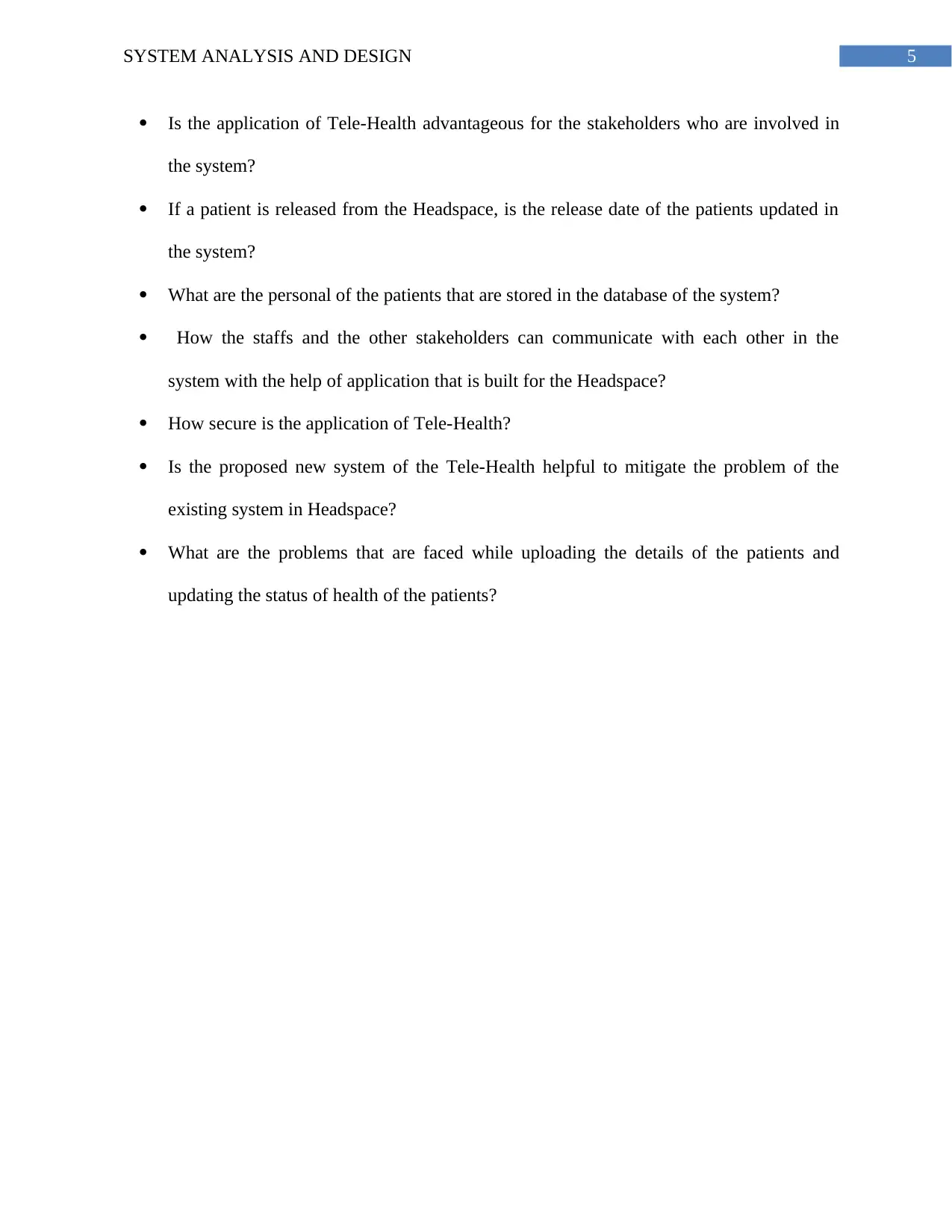
5SYSTEM ANALYSIS AND DESIGN
Is the application of Tele-Health advantageous for the stakeholders who are involved in
the system?
If a patient is released from the Headspace, is the release date of the patients updated in
the system?
What are the personal of the patients that are stored in the database of the system?
How the staffs and the other stakeholders can communicate with each other in the
system with the help of application that is built for the Headspace?
How secure is the application of Tele-Health?
Is the proposed new system of the Tele-Health helpful to mitigate the problem of the
existing system in Headspace?
What are the problems that are faced while uploading the details of the patients and
updating the status of health of the patients?
Is the application of Tele-Health advantageous for the stakeholders who are involved in
the system?
If a patient is released from the Headspace, is the release date of the patients updated in
the system?
What are the personal of the patients that are stored in the database of the system?
How the staffs and the other stakeholders can communicate with each other in the
system with the help of application that is built for the Headspace?
How secure is the application of Tele-Health?
Is the proposed new system of the Tele-Health helpful to mitigate the problem of the
existing system in Headspace?
What are the problems that are faced while uploading the details of the patients and
updating the status of health of the patients?
⊘ This is a preview!⊘
Do you want full access?
Subscribe today to unlock all pages.

Trusted by 1+ million students worldwide
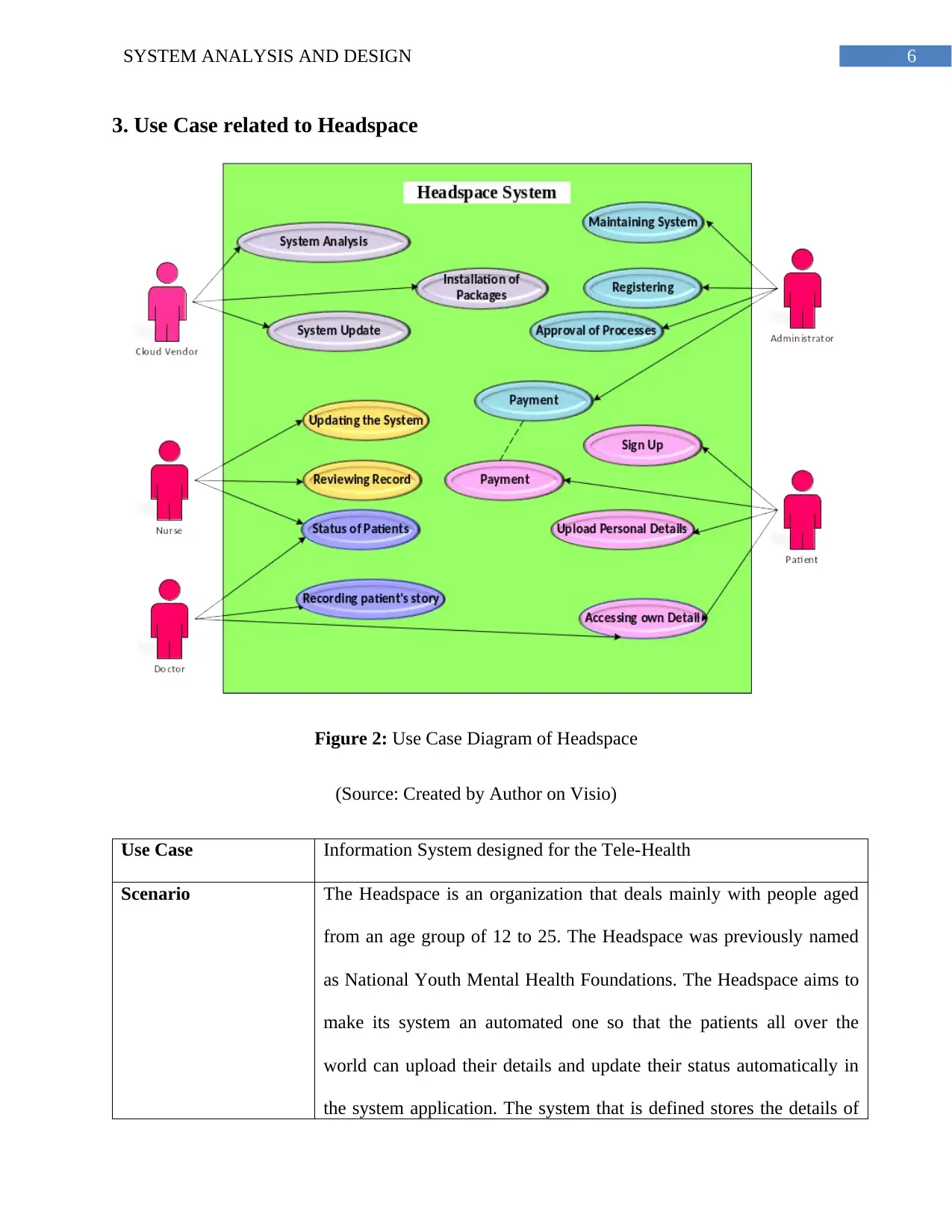
6SYSTEM ANALYSIS AND DESIGN
3. Use Case related to Headspace
Figure 2: Use Case Diagram of Headspace
(Source: Created by Author on Visio)
Use Case Information System designed for the Tele-Health
Scenario The Headspace is an organization that deals mainly with people aged
from an age group of 12 to 25. The Headspace was previously named
as National Youth Mental Health Foundations. The Headspace aims to
make its system an automated one so that the patients all over the
world can upload their details and update their status automatically in
the system application. The system that is defined stores the details of
3. Use Case related to Headspace
Figure 2: Use Case Diagram of Headspace
(Source: Created by Author on Visio)
Use Case Information System designed for the Tele-Health
Scenario The Headspace is an organization that deals mainly with people aged
from an age group of 12 to 25. The Headspace was previously named
as National Youth Mental Health Foundations. The Headspace aims to
make its system an automated one so that the patients all over the
world can upload their details and update their status automatically in
the system application. The system that is defined stores the details of
Paraphrase This Document
Need a fresh take? Get an instant paraphrase of this document with our AI Paraphraser
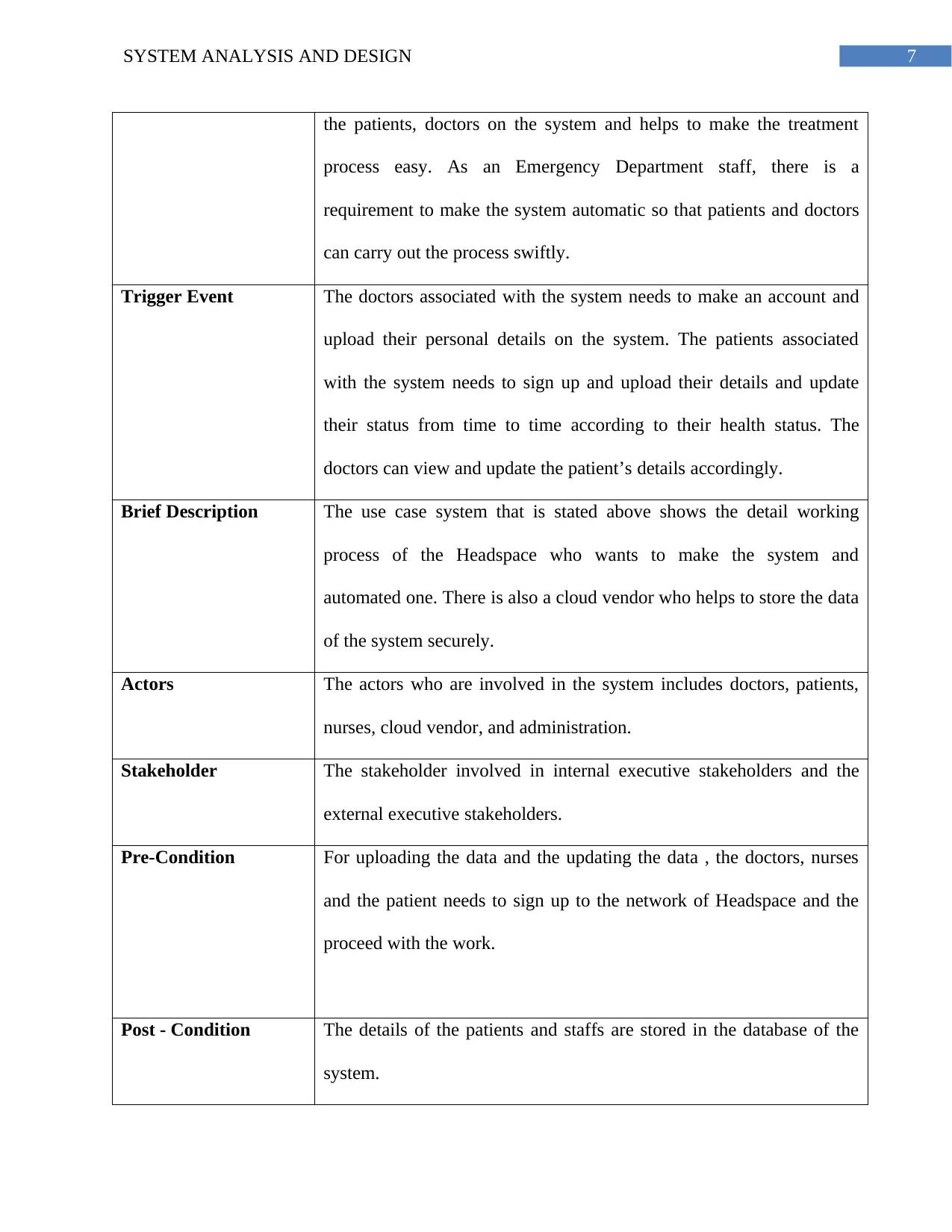
7SYSTEM ANALYSIS AND DESIGN
the patients, doctors on the system and helps to make the treatment
process easy. As an Emergency Department staff, there is a
requirement to make the system automatic so that patients and doctors
can carry out the process swiftly.
Trigger Event The doctors associated with the system needs to make an account and
upload their personal details on the system. The patients associated
with the system needs to sign up and upload their details and update
their status from time to time according to their health status. The
doctors can view and update the patient’s details accordingly.
Brief Description The use case system that is stated above shows the detail working
process of the Headspace who wants to make the system and
automated one. There is also a cloud vendor who helps to store the data
of the system securely.
Actors The actors who are involved in the system includes doctors, patients,
nurses, cloud vendor, and administration.
Stakeholder The stakeholder involved in internal executive stakeholders and the
external executive stakeholders.
Pre-Condition For uploading the data and the updating the data , the doctors, nurses
and the patient needs to sign up to the network of Headspace and the
proceed with the work.
Post - Condition The details of the patients and staffs are stored in the database of the
system.
the patients, doctors on the system and helps to make the treatment
process easy. As an Emergency Department staff, there is a
requirement to make the system automatic so that patients and doctors
can carry out the process swiftly.
Trigger Event The doctors associated with the system needs to make an account and
upload their personal details on the system. The patients associated
with the system needs to sign up and upload their details and update
their status from time to time according to their health status. The
doctors can view and update the patient’s details accordingly.
Brief Description The use case system that is stated above shows the detail working
process of the Headspace who wants to make the system and
automated one. There is also a cloud vendor who helps to store the data
of the system securely.
Actors The actors who are involved in the system includes doctors, patients,
nurses, cloud vendor, and administration.
Stakeholder The stakeholder involved in internal executive stakeholders and the
external executive stakeholders.
Pre-Condition For uploading the data and the updating the data , the doctors, nurses
and the patient needs to sign up to the network of Headspace and the
proceed with the work.
Post - Condition The details of the patients and staffs are stored in the database of the
system.
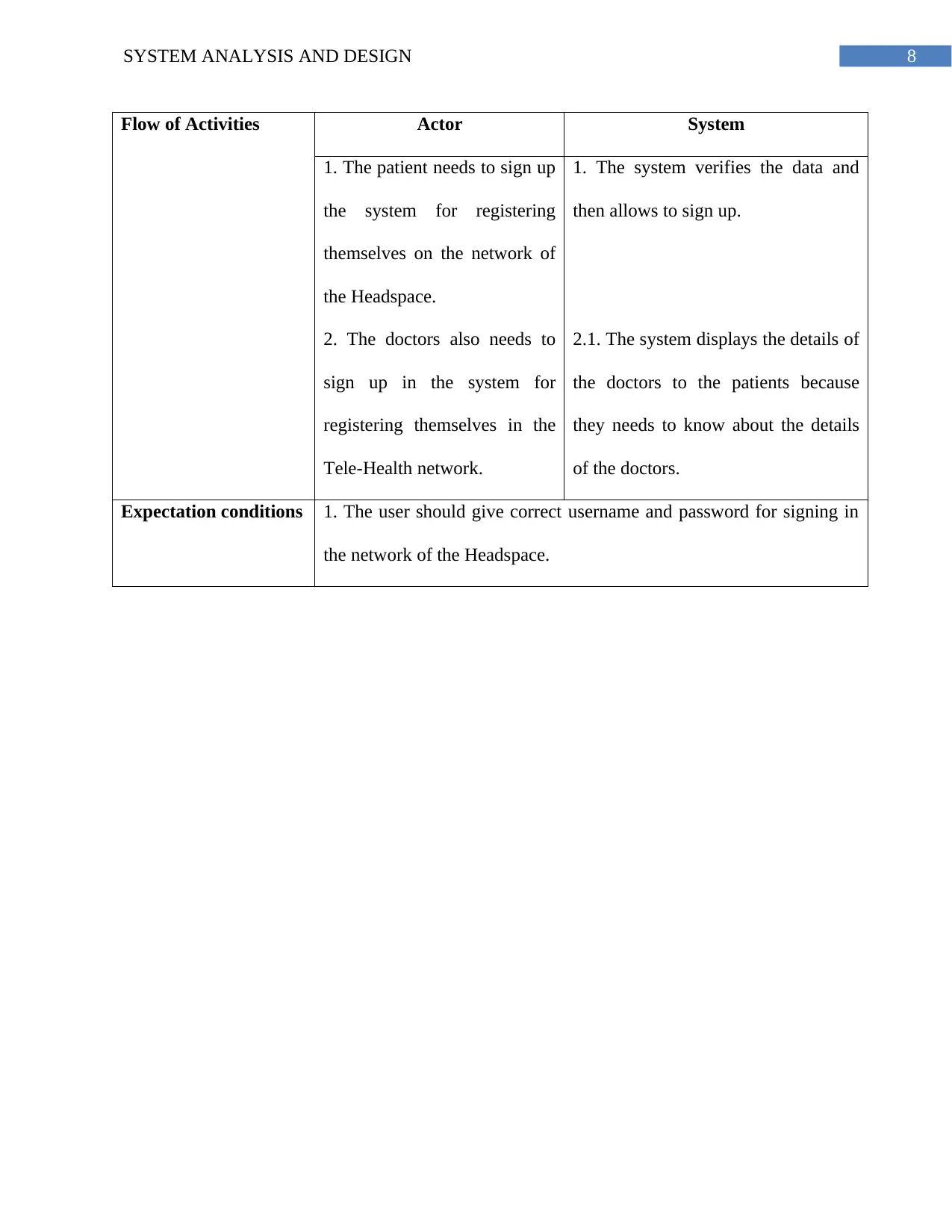
8SYSTEM ANALYSIS AND DESIGN
Flow of Activities Actor System
1. The patient needs to sign up
the system for registering
themselves on the network of
the Headspace.
2. The doctors also needs to
sign up in the system for
registering themselves in the
Tele-Health network.
1. The system verifies the data and
then allows to sign up.
2.1. The system displays the details of
the doctors to the patients because
they needs to know about the details
of the doctors.
Expectation conditions 1. The user should give correct username and password for signing in
the network of the Headspace.
Flow of Activities Actor System
1. The patient needs to sign up
the system for registering
themselves on the network of
the Headspace.
2. The doctors also needs to
sign up in the system for
registering themselves in the
Tele-Health network.
1. The system verifies the data and
then allows to sign up.
2.1. The system displays the details of
the doctors to the patients because
they needs to know about the details
of the doctors.
Expectation conditions 1. The user should give correct username and password for signing in
the network of the Headspace.
⊘ This is a preview!⊘
Do you want full access?
Subscribe today to unlock all pages.

Trusted by 1+ million students worldwide
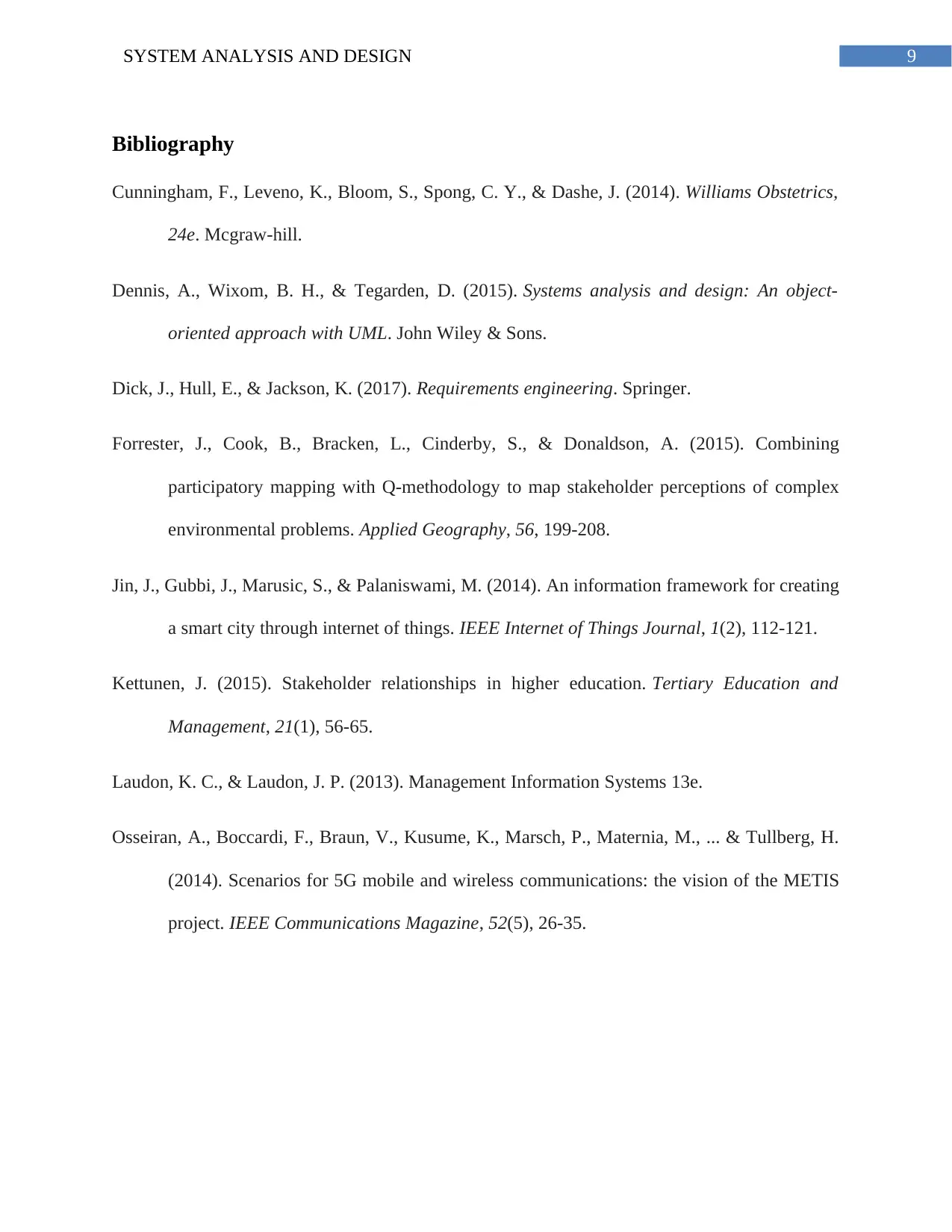
9SYSTEM ANALYSIS AND DESIGN
Bibliography
Cunningham, F., Leveno, K., Bloom, S., Spong, C. Y., & Dashe, J. (2014). Williams Obstetrics,
24e. Mcgraw-hill.
Dennis, A., Wixom, B. H., & Tegarden, D. (2015). Systems analysis and design: An object-
oriented approach with UML. John Wiley & Sons.
Dick, J., Hull, E., & Jackson, K. (2017). Requirements engineering. Springer.
Forrester, J., Cook, B., Bracken, L., Cinderby, S., & Donaldson, A. (2015). Combining
participatory mapping with Q-methodology to map stakeholder perceptions of complex
environmental problems. Applied Geography, 56, 199-208.
Jin, J., Gubbi, J., Marusic, S., & Palaniswami, M. (2014). An information framework for creating
a smart city through internet of things. IEEE Internet of Things Journal, 1(2), 112-121.
Kettunen, J. (2015). Stakeholder relationships in higher education. Tertiary Education and
Management, 21(1), 56-65.
Laudon, K. C., & Laudon, J. P. (2013). Management Information Systems 13e.
Osseiran, A., Boccardi, F., Braun, V., Kusume, K., Marsch, P., Maternia, M., ... & Tullberg, H.
(2014). Scenarios for 5G mobile and wireless communications: the vision of the METIS
project. IEEE Communications Magazine, 52(5), 26-35.
Bibliography
Cunningham, F., Leveno, K., Bloom, S., Spong, C. Y., & Dashe, J. (2014). Williams Obstetrics,
24e. Mcgraw-hill.
Dennis, A., Wixom, B. H., & Tegarden, D. (2015). Systems analysis and design: An object-
oriented approach with UML. John Wiley & Sons.
Dick, J., Hull, E., & Jackson, K. (2017). Requirements engineering. Springer.
Forrester, J., Cook, B., Bracken, L., Cinderby, S., & Donaldson, A. (2015). Combining
participatory mapping with Q-methodology to map stakeholder perceptions of complex
environmental problems. Applied Geography, 56, 199-208.
Jin, J., Gubbi, J., Marusic, S., & Palaniswami, M. (2014). An information framework for creating
a smart city through internet of things. IEEE Internet of Things Journal, 1(2), 112-121.
Kettunen, J. (2015). Stakeholder relationships in higher education. Tertiary Education and
Management, 21(1), 56-65.
Laudon, K. C., & Laudon, J. P. (2013). Management Information Systems 13e.
Osseiran, A., Boccardi, F., Braun, V., Kusume, K., Marsch, P., Maternia, M., ... & Tullberg, H.
(2014). Scenarios for 5G mobile and wireless communications: the vision of the METIS
project. IEEE Communications Magazine, 52(5), 26-35.
1 out of 10
Related Documents
Your All-in-One AI-Powered Toolkit for Academic Success.
+13062052269
info@desklib.com
Available 24*7 on WhatsApp / Email
![[object Object]](/_next/static/media/star-bottom.7253800d.svg)
Unlock your academic potential
Copyright © 2020–2025 A2Z Services. All Rights Reserved. Developed and managed by ZUCOL.




